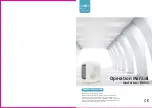
Maintenance
36
RT-SVX33E-EN
Filters
Inspect the return air filters. Clean or replace them if
necessary. Refer to the unit Service Facts for filter
information.
Condensate Overflow Switch
During maintenance, the switch float (black ring) must be
checked to ensure free movement up and down.
Return Air Smoke Detector Maintenance
Airflow through the unit is affected by the amount of dirt
and debris accumulated on the indoor coil and filters. To
insure that airflow through the unit is adequate for proper
sampling by the return air smoke detector, complete
adherence to the maintenance procedures, including
recommended intervals between filter changes, and coil
cleaning is required.
Periodic checks and maintenance procedures must be
performed on the smoke detector to insure that it will
function properly. For detailed instructions concerning
these checks and procedures, refer to the appropriate
section(s) of the smoke detector Installation and
Maintenance Instructions provided with the literature
package for this unit.
Cooling Season
•
Check the unit’s drain pans and condensate piping to
ensure that there are no blockages.
•
Inspect the evaporator and condenser coils for dirt,
bent fins, etc. If the coils appear dirty, clean them
according to the instructions described in “Coil
Cleaning” later in this section.
•
Manually rotate the condenser fan(s) to ensure free
movement and check motor bearings for wear. Verify
that all of the fan mounting hardware is tight.
•
Inspect the F/A-R/A damper hinges and pins to ensure
that all moving parts are securely mounted. Keep the
blades clean as necessary.
•
Verify that all damper linkages move freely; lubricate
with white grease, if necessary.
•
Check supply fan motor bearings; repair or replace the
motor as necessary.
•
Check the fan shaft bearings for wear. Replace the
bearings as necessary.
•
Check the supply fan belt. If the belt is frayed or worn,
replace it. Refer to the “Fan Belt Adjustment” section
for belt replacement and adjustments.
•
Verify that all wire terminal connections are tight.
•
Remove any corrosion present on the exterior surfaces
of the unit and repaint these areas.
•
Generally inspect the unit for unusual conditions (e.g.,
loose access panels, leaking piping connections, etc.)
•
Make sure that all retaining screws are reinstalled in
the unit access panels once these checks are complete.
•
With the unit running, check and record the: ambient
temperature; compressor suction and discharge
pressures (each circuit); superheat (each circuit);
Record this data on an “operator’s maintenance log” like
the one shown in
Table 11, p. 37
. If the operating pressures
indicate a refrigerant shortage, measure the system
superheat. For guidelines, refer to the “Compressor Start-
Up” section.
Note:
Do not release refrigerant to the atmosphere! If
adding or removing refrigerant is required, the
service technician must comply with all federal,
state and local laws.
Heating Season
•
Inspect the unit’s air filters. If necessary, clean or
replace them.
•
Check supply fan motor bearings; repair or replace the
motor as necessary.
•
Inspect both the main unit control panel and heat
section control box for loose electrical components
and terminal connections, as well as damaged wire
insulation. Make any necessary repairs.
•
Verify that the electric heat system operates properly.
Coil Cleaning
Regular coil maintenance, including annual cleaning,
enhances the unit’s operating efficiency by minimizing:
compressor head pressure and amperage draw;
evaporator water carryover; fan brake horsepower, due to
increase static pressure losses; airflow reduction.
At least once each year, or more often if the unit is located
in a “dirty” environment, clean the evaporator and
condenser coils using the instructions outlined below. Be
sure to follow these instructions as closely as possible to
avoid damaging the coils.
To clean refrigerant coils, use a soft brush and a sprayer
(either a garden pump-up type or a high-pressure sprayer).
A high-quality detergent is also required; suggested
brands include “SPREX A.C.”, “OAKITE 161”, “OAKITE 166”
and “COILOX”. If the detergent selected is strongly alkaline
(ph value exceeds 8.5), add an inhibitor.
1.
Remove enough panels from the unit to gain access to
the coil. Remove the access panel from the roof located
next to the rear condenser fan.
2. Protect all electrical devices such as motors and
controllers from any over spray.
3. Straighten any bent coil fins with a fin comb.
4. Mix the detergent with water according to the
manufacturer’s instructions. If desired, heat the
solution to 150° F maximum to improve its cleansing
capability.









































